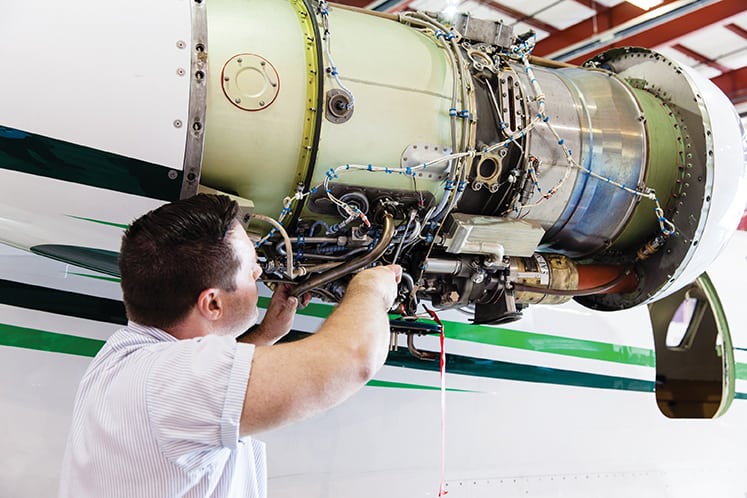
The FAA published Revision B to AC 20-165B, which provides aviation industry guidance for the installation and airworthiness approval for Automatic Dependent Surveillance Broadcast Out (ADS-B Out) avionics solutions. We talked to industry experts about what the changes mean for operators.
At the end of 2015, the FAA published Advisory Circular 20-165B (AC 20-165B), a revision to its previously existing guidance for installation and airworthiness approval for Automatic Dependent Surveillance-Broadcast Out (ADS-B Out) avionics. The AC is 113 pages total, 28 pages more than the previous aircraft guidance on ADS-B, published in 2012.
As with the preceding guidance, the agency intended the revised guidance for all individuals that are applying for an initial Type Certificate (TC), Supplemental Type Certificate (STC) or an amended STC or TC for ADS-B Out solutions.
According to Melissa Rudinger, senior vice president for government affairs at the Aircraft Owners and Pilots Association (AOPA), there are some changes contained within the revised guidance that make the path to equipage easier for business and general aviation operators looking to comply with the Jan. 1, 2020 airspace mandate.
“For the installation itself, it’s a huge benefit in that it is no longer considered a major alteration,” says Rudinger, noting that AC 20-165B, no longer treats ADS-B Out transmitters and position automatically as a major change to the airframe and instead, the new guidance treats ADS-B Out installations as normal avionics, within specific limitations.
The other two major changes in the new guidance are that the revised AC features follow on installation criteria for a previously approved system as well as for the reuse of flight test data for follow-on installations of approved systems.
Rudinger says the revised guidance’s changing of ADS-B Out installations and airworthiness guidance to a non-major has been helpful and also reflects trends with how the FAA introduces and gradually accepts new aircraft equipment.
 |
| Elliott Aviation Jet Service Center in Moline, Illinois. Photo courtesy of Elliott Aviation. |
“While the equipment itself still has to have initial certification, it’s now treated like any other normal avionics installation. That’s going to help lower the cost for both avionics shops to perform the installation, as well as to reduce the cost that the operator will have to pay. Of course, the cost of compliance is also dependent upon what is already on the aircraft and how the aircraft’s avionics equipment has been modified over the time that it has been owned and operated,” says Rudinger.
Another change in the new guidance is a modification to ADS-B equipment eligibility. Under the new AC, all equipment is still required to meet the performance requirements of TSO C166b or TSO C154C, but the agency also provides an option to deviate from rule requirements with approval from the FAA proving that factors or design features provide an adequate level of safety for the equipment standards from which a deviation is requested.
Under the third chapter for ADS-B Out System Installation guidance, within the guidance for air to ground communications, the FAA added a note for rotorcraft regarding the GPS algorithms that need to be tested and validated in order to derive the air-to-ground status of a rotorcraft:
“Rotorcraft may require unique logic for providing an accurate air-ground state. A reliable method to determine the air-ground state should consider training requirements. Rotorcraft may consider hover taxi as in the air,” AC 20-165B states.
The revised guidance has been one of several moves that the FAA took over the last year as part of its ongoing Equip 2020 initiative, which aims to help all segments of the aviation industry become educated, equipped and compliant with the ADS-B Out rule.
AOPA’s Rudinger says equipage rates have improved with the FAA’s efforts over the past year to improve its outreach to the general aviation community and streamline available information and sources for ADS-B equipment.
Regardless of new guidance, aircraft owners and operators looking to get the best possible deal on compliant ADS-B solutions still have to go through the same lengthy, individualized process as before, says Mark Wilken, vice president of avionics programs and logistics at Elliott Aviation, a Fixed-Base Operator (FBO) that performs avionics services and installations on light business jets and general aviation aircraft.
“We have to look at each aircraft, each individual serial number. It’s not a one fix for everything. Some airplanes that have a little bit newer setup with a little bit easier way to get there, they might be $20,000 to $25,000 to get to ADS-B. Other aircraft, there’s numbers up to $275,000 to get to ADS-B. It’s a range. What I encourage pilots to do right now is to do their research, start making phone calls and talk with companies that normally work on those kind of airplanes,” says Wilken.